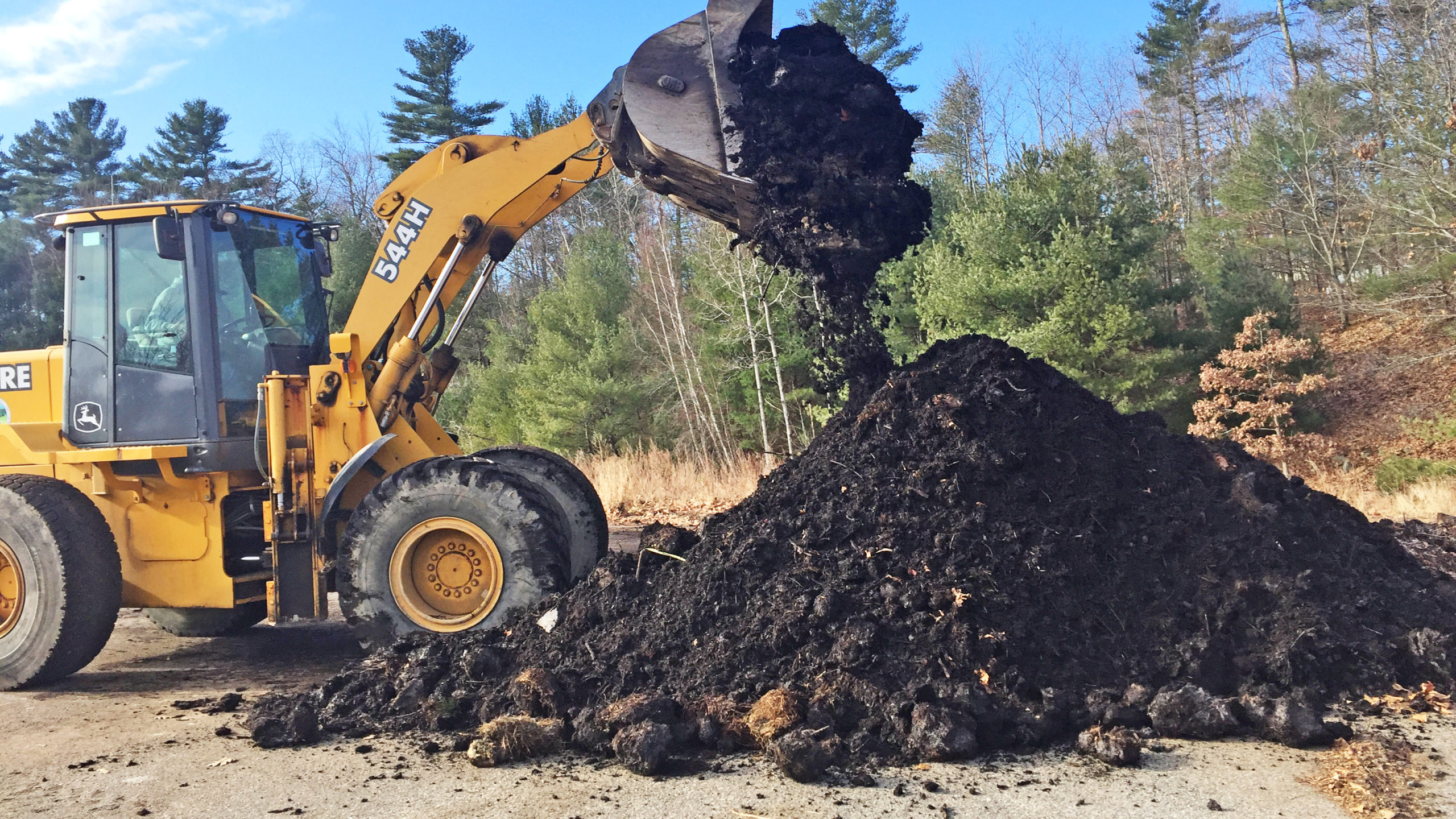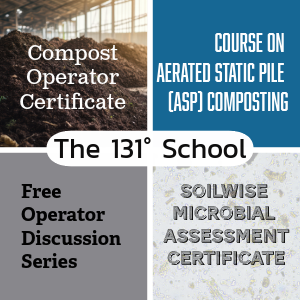Top: Preparing a mix of amendments for seal carcass composting.
Mark A. King

Marine Mammals of Maine or the College of the Atlantic would send staff to assess, measure and take samples from each mortality. Photos courtesy of Mark King
During the summer of 2018, the State of Maine, along with the neighboring states of New Hampshire and Massachusetts, experienced a sudden increase in Harbor Seal (Phoca vitulina) and Gray Seal (Halichoerus grypus) mortalities. On August 31, 2018, in response to this developing crisis, the National Oceanic and Atmospheric Administration (NOAA) national Working Group on Marine Mammal Unusual Mortality Events (UME) declared that a UME was occurring based on two out of seven defining criteria being met (NOAA, 2019):
- A marked increase in the magnitude or a marked change in the nature of morbidity, mortality, or strandings when compared with prior records.
- Affected animals exhibit similar or unusual pathologic findings, behavior patterns, clinical signs, or general physical condition (e.g., blubber thickness).
Scientists from NOAA verified that the bulk of the mortalities had resulted from exposure to the Phocine Morbillivirus, aka, Phocine Distemper Virus (PDV). Pádraig et al. (2014) suggests that the emergence of PDV and other similar viruses may be due to climate changing factors that result in a mass influx of new aquatic species to the traditionally colder Atlantic waters, exposing immunologically susceptible populations. They further postulate that another possible explanation could be environmental changes induced by the introduction of man-made pollutants are interfering with marine mammal populations and their ability to fight off the effects of these pathogens.
By the end of September 2018, a total of 1,366 seals had washed up along beaches from Bar Harbor, Maine to Cape Cod, Massachusetts. Maine was the hardest hit state, experiencing a total of 1,032 reported cases. NOAA’s announcement, coupled with the ever-growing number of mortalities, prompted the Maine Department of Environmental Protection (MEDEP) to convene a multi-agency task force (team) to discuss management of the growing mortality numbers and what to do about it. The task force consisted of members from four state agencies and NOAA. MEDEP served as team leader, providing community outreach and technical expertise. The Department of Agriculture, Conservation and Forestry coordinated the animal disease response and also helped to choose suitable sites for mortality management activities. The Maine Center for Disease Control provided educational materials and answers to disease and public health-related questions, and Marine Mammals of Maine (MMOME) identified mortality locations and completed initial mortality assessment and sampling. NOAA coordinated the national response.
At its first meeting on September 11, 2018, the team discussed the epidemic and ways to head off the growing public concern over the mass strandings. Given Maine’s reputation as a “Vacationland,” it became paramount to ensure that beach-going members of the public and their pet dogs (who are susceptible to PDV) not come in contact with these mortalities. Finding a way to address the mounting mortalities while simultaneously neutralizing the virus became an important consideration. The team discussed various disposal options and very quickly reached a consensus on using a community-based composting model as numerous studies had previously demonstrated the efficacy of composting in managing viral pathogens in animal carcasses (Senne et al. (1994), Garcia-Sierra J. et al. (2001), Guardabassi et al. (2003), Lu et al. (2003), Gwyther et al. (2010), Guan et al. (2010), Guan et al. (2012) and Paluszak and Ligocka (2012)).
Community-Based Composting Model
Many of the traditional mortality disposal methods such as burial and incineration have proven to be costly, environmentally unfriendly practices. To be considered a viable solution, mortality management options must be cost effective, environmentally sound and, ultimately, protective of public health.
Composting mortalities provides an inexpensive mechanism that addresses all of these key criteria. Animal carcasses are ideally suited for composting, providing the most important element necessary to drive the compost system, nitrogen (Carr, 2004). Previous studies have documented successful composting of animal carcasses using a host of ingredients, including: sawdust (Glanville (1995), Glanville and Trampel (1997), Keener et al. (2000) and Carr (2004)), animal manure and sawdust combinations (Looper (2001), and Mukhtar (2003), and wood chips (Bonhotal, 2004).
The plan developed by the team allowed for emergency composting to immediately take place within eight coastal Maine communities (Falmouth, Kennebunkport, Ogunquit, Old Orchard Beach, Saco, Yarmouth, York, and Wells). A fact sheet and guidance document (Notification, Handling and Disposal Procedures for Marine Mammal Carcasses) were created and between late September and October 2018, MEDEP staff met with eight Maine Coastal communities to set up mortality composting operations. The process included several important components that relied heavily upon each coastal communities’ willingness to take an active role in the response for strandings within their boundaries.
Once a stranded animal was located, complainants were requested to call their local police department. Emergency dispatchers would then notify the Maine Marine Animal Reporting Hotline and either the MMOME or College of the Atlantic would send staff to assess, measure and take samples from each mortality.

Local news coverage helped get the word out about alerting authorities when a carcass was found stranded.
The next step was to notify the MEDEP and then a community response was initiated. This included coordinating with Town/City Police, Harbor Masters, Public Works and any other interested municipal officials to immediately retrieve the animal and bring it to a safe, secure location for composting. MEDEP staff would then arrive and help the community set up their initial pile, ensuring that the site was properly evaluated, general siting criteria were met, and that the locations would not create odors, attract scavenging animals or pollute ground and surface waters. Since most of these communities already had an existing leaf and yard trimmings composting operation, it was decided to add mortalities to active, working piles as opposed to trying to develop new sites. The following methodology was used to construct piles (King et al., 2005):
- A “bed” of carbonaceous materials (base), usually 18 to 24 inches in depth, and large enough to surround the entire carcass was laid out using “biologically active” materials such as fresh horse bedding. This is preferred as it provides a jump-start on the composting process. Additionally, this initial layer serves as a barrier to help absorb any liquids that are liberated by the carcass as it decomposes.
- The carcass was placed on the center of the bed, making certain that none of the carcass extended beyond the edge. Carcasses were vented in numerous locations to release trapped gasses and allow abdominal contents an opportunity to mix with compost ingredients.
 Carcasses — averaging 350 to 400 pounds and 5- to 7- feet in length — were covered with a minimum of 18 to 24 inches (additional cover material may be necessary on a case-by-case basis) of carbonaceous cover material to form a natural biofilter to eliminate odorous emissions and discourage attraction of scavenging animals. Again, a biologically active material is preferred for covering carcasses. The finished pile should be conical in shape with steep sides to help shed precipitation (Figure 1).
Carcasses — averaging 350 to 400 pounds and 5- to 7- feet in length — were covered with a minimum of 18 to 24 inches (additional cover material may be necessary on a case-by-case basis) of carbonaceous cover material to form a natural biofilter to eliminate odorous emissions and discourage attraction of scavenging animals. Again, a biologically active material is preferred for covering carcasses. The finished pile should be conical in shape with steep sides to help shed precipitation (Figure 1).
Once the initial pile had been established and Public Works staff were comfortable with the overall process, subsequent piles would be formed without MEDEP assistance.
Newly formed piles were left undisturbed for a six-week period (precautionary requirement of the both the State and Federal veterinarians). Piles were monitored daily for temperatures and overall pile integrity to ensure that “cracks” did not form in the bulking agent. As the carcass continues to break down, these cracks could become point sources for odor releases and initiation of scavenging activity. This is especially true during the first week, when carcasses initially discharge a large volume of fluids into the bulking agent, causing the body to collapse and fissures to form along the top edges of the compost pile. Any and all cracks were repaired simply by using a hand rake or other tool to smooth over the disturbed areas, thus eliminating odor sources.
Piles responded fairly quickly to the mortality introductions, especially once the carcass started to break down and began releasing nutrients. Most facilities reported sustained pile temperatures in excess of 130°F for greater than 3-week periods, and reaching up to 160°F. In all cases, pile excavations, following six-weeks of active composting, revealed mostly bones with some “slimy” films still coating them. Throughout the process, none of the compost piles experienced any vector activity nor were any odor complaints received.
The length of curing varied from 3 to 6 months depending on space and storage constraints at the facility. MEDEP did not test the finished compost for the distemper virus as it is known to be a very weak environmental virus. However, to be safe, all compost was not sold, but used mostly around the facilities where it was generated.
Recommendations
King et al. (2005), reports that on-site management is crucial throughout any mortality composting event, especially during the first two weeks. In addition, they provided the following “key” Best Management Practices to ensure successful carcass composting:
- Good site and carcass preparation facilitate carcass decomposition without causing nuisance odors, vector attraction issues, or generation of nutrient-rich leachate.
- Piles should be constructed using compost mixes with moderate bulk densities (300-550 lbs/cy), optimal C:N ratios (25 to 40), good texture (appropriate mix of fine and coarse particles) and optimal porosity and pile structure.
- Horse bedding and other biologically active materials are ideal for most carcass management scenarios.
- Carcasses must be vented in numerous locations to release trapped gasses and allow abdominal contents an opportunity to mix with compost ingredients.
- Carcasses should be covered with 24 to 36 inches of cover material. This should be monitored during the first two weeks of composting, as carcasses slump, causing pile structure to collapse.
- Any occurrences of odors or maggots must be addressed before scavenging animals arrive by covering with an appropriate amount of amendment to reduce odor.
- Leachate pools should be absorbed with excess amendment and incorporated into piles to prevent odors.

The 7th Annual Symposium on Animal Mortality Management, June 13-16, 2022, will cover a wide range of topics, including composting.
Conclusions
Composting has been the “Maine Response” to mortality management for decades. In the case of the 2018 UME, composting proved to be the first, best and most effective option. All of the community-based composting piles performed extremely well as evidenced by sustained, recorded temperatures in excess of 130°F and complete carcass degradation in less than eight weeks. In addition, all piles remained odor, leachate and vector free throughout the entire compost period. Going forward, this methodology will be the standing order for managing mortalities from UMEs.
Mark A. King is an Environmental Specialist with the Maine Department of Environmental Protection in Augusta, Maine.















